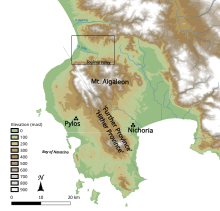
The University of Minnesota Messenia Expedition (UMME) was an archaeological expedition in Messenia, Greece, conducted between 1953 and 1975. It was devised and begun by William McDonald, who also served as its director for most of its duration.
The project had its origins in the decipherment of Linear B in the early 1950s, and the consequent realisation that the Linear B tablets unearthed at the site of Pylos in Messenia – where McDonald had excavated since 1939 – had been the centre of a Mycenaean polity that controlled sites across the region. In the early 1950s, McDonald, soon joined by Richard Hope Simpson, carried out field surveys to match the toponyms given in the Linear B tablets from the Palace of Nestor at Pylos to then-undiscovered archaeological sites in Messenia. Throughout the 1950s and 1960s, the project expanded to survey 3,800 square kilometres (1,500 sq mi) of territory, gathering records of habitation from the Neolithic to the Medieval periods.
The UMME's work established Messenia as one of the best-studied regions of Mycenaean Greece, and has been cited as an inspiration for numerous other archaeological projects in Greece. Its distinctive methods included the involvement of specialists in scientific fields, such as geologists and botanists, as well as its diachronic perspective, including the study of the modern human geography and anthropological investigation as a means of generating hypotheses about the ancient exploitation and habitation of the region.
Between 1969 and 1975, the expedition carried out the excavation of Nichoria, a Mycenaean and Early Iron Age site in southern Messenia, which proved a significant source of information about the end of the Bronze Age in Greece, as well as a proving ground and case study for the use of scientific, multi-disciplinary methods in archaeological excavation. Animal bone remains found at the site have become significant in reconstructing the diets of people in Mycenaean and Early Iron Age Greece, and a debated source of evidence for social changes at the end of the Mycenaean period.